During a recent return to Saxony, his Mother Lodge, WBro Ray Barnett was in discussion with the Worshipful Master on the subject of a reunion he recently attended with John Perry, the son of Arthur Perry, a founder member of Saxony Lodge.
Whilst in conversation with Ray, John mentioned the fact that there was a presentation that had been given in respect of Freemasonry and prisoners of war. This lecture was of particular poignancy as the latter part was about John's father, Arthur and his experiences as a Prisoner of War of the Japanese.
It was therefore suggested that as Arthur was a founder member of this Lodge, the presentation be included in the Lodge history and perhaps be released to the greater Masonic Community. WBro Ray sent me the information along with photos and I read the presentation with great interest. As I reached the latter part of the presentation I tried to envisage myself in the position, they as prisoners were in and I could not. The lack of contact with the outside world, the treatment, the hardship, the lack of knowing your own future and of course that what is not often depicted in films, the boredom.
As an old soldier and a Mason I found Arthur's story touching in many ways as I am sure many of you will. I have transposed the presentation onto this web page for you all to read at your leisure. I thank the author for his efforts in bringing this to the Masonic community, to Arthur's family for the images and WBro Ray for bringing this fascinating presentation in particular to our attention.
Whilst in conversation with Ray, John mentioned the fact that there was a presentation that had been given in respect of Freemasonry and prisoners of war. This lecture was of particular poignancy as the latter part was about John's father, Arthur and his experiences as a Prisoner of War of the Japanese.
It was therefore suggested that as Arthur was a founder member of this Lodge, the presentation be included in the Lodge history and perhaps be released to the greater Masonic Community. WBro Ray sent me the information along with photos and I read the presentation with great interest. As I reached the latter part of the presentation I tried to envisage myself in the position, they as prisoners were in and I could not. The lack of contact with the outside world, the treatment, the hardship, the lack of knowing your own future and of course that what is not often depicted in films, the boredom.
As an old soldier and a Mason I found Arthur's story touching in many ways as I am sure many of you will. I have transposed the presentation onto this web page for you all to read at your leisure. I thank the author for his efforts in bringing this to the Masonic community, to Arthur's family for the images and WBro Ray for bringing this fascinating presentation in particular to our attention.
Let me now try to bring this address to a personal level. In my mother Lodge, when I was initiated in Malta, the Secretary was one W Bro Arthur Perry. A wonderful and kind man, well skilled in the Masonic arts and I am delighted to say that his son, E Comp John Perry is present today. A few weeks ago, I casually mentioned to John that I was intending to address the Chapter on this subject and he said "Oh, my father was a POW in Changi during the war - I have a few letters from him. Would they be of any help"? I am extremely grateful to John for providing me with copies of various documents relating to Arthur's experiences at the hands of the Japanese. I am also extremely grateful to John for allowing me to read from what are very personal letters. Arthur was a member of the Craft at the time of his capture, but there is no record of him having attended Masonic Meetings while a POW. It is possible of course but he had only been Initiated, Passed and Raised in 1941 and was therefore very inexperienced. He was due to be Exalted into RA Masonry in January 1942, but the Convocation was called off, due to enemy action which resulted in the fall of Singapore in February 1942.
In April 1942, only weeks after his capture, he wrote to his father and I would like to read some of what he said.
Quote. Of the fall of Malaya and Singapore I had better not write, except to say that the enemy fought with "the will to win" and we did not. That we were outnumbered very greatly is admitted, that we had no Air Force is also agreed, but I am sure that if this Island had been England, we should still be holding out. The British and Ghurkhas fought well - the Australian regulars also did great work. A great number of the Australians had no heart in it towards the end and the majority of Indians just ran, having first thrown their arms away.
The air bombings on Singapore were incessant during the last two weeks and the last week we were shelled and shelled, machine gunned and bombed for most of the twenty four hours. Unquote. He then goes on to express his pleasure at knowing his young wife, who was pregnant with their first child, had escaped to Australia. He then goes on. Quote. Returning to our present position here - I must say that with a few exceptions, such as short rations, face slapping and putting Indian Guards over us, the Japanese have behaved most courteously and what is more like real soldiers. The hospitals are full. Dysentery has raged and the latest scare is Beriberi. So far I have missed both and pray God I will successfully see this Camp through without sickness. Unquote he goes on to say that if rumours are correct, June 1942, or July 1942 should see the POWs freed. In reality it was not until late 1945 that Arthur was reunited with his family.
In his letters he describes keeping a diary and planning a future detailed tour of Great Britain by car, with his father and other members of his family being his guests during parts of his tour. He states that it should take two weeks and cost £100!!! In addition he describes the everyday tasks: wood chopping, cooking, gardening, carpentry and playing games. He also attempted to learn Russian, the mother tongue of his wife, Alexandra. Perhaps out of deference to his father he does not mention what work he was forced to carry out by the Japanese. In June 1942 he writes that he is to be moved to an unknown destination, which turned out to be Thailand.
Arthur is generous in his comments about the Japanese particularly in the early days of his captivity, but this was to change, as like many POW colleagues, Arthur was to witness terrible atrocities committed by the Japanese Military High Command (see newspaper cutting from Melbourne ARGUS 9th December 1947, which Alexandra had kept and which Arthur had witnessed). E Comp John, Arthur's son describes how his father kept a photograph of his wife, but because personal possessions that could give POWs peace of mind and comfort were taken away and destroyed, Arthur buried the photograph and periodically, dug it up to remind himself of his young wife and unborn child. Only later did he find out that the Japanese NCO in charge of his group knew of the photo. You may question what punishment was inflicted on Arthur as a result of this transgression. The answer Companions is none, but rather the opposite. After the surrender of the Japanese, Arthur was in charge of the unit guarding their Prisoner of War Guards, although at this point a very ill man. (He was to spend many months in and out of hospital for major surgery on his return to the UK). It was at this point that the Japanese Warrant Officer revealed to Arthur that he had known of the existence of the buried photograph, which came as a great shock, knowing what the potential punishment could have been. The soldier revealed that he was an artist in his civilian life and asked if he could draw Alexandra from the buried photographs. The NCO gave Arthur this drawing of his wife which he had copied from the photograph. The drawing is done in charcoal and white chalk is on brown paper from a Red Cross parcel. I tell you this because while there are numerous stories of ill treatment of POWs at the hands of the Japanese - this story illustrates that even under terrible conditions there are still incidents of genuine humanity.
Before I close, let me tell you one other story. I sent the first draft of this address to John and asked him to confirm that I had correctly interpreted Arthur's POW history. A few days later John contacted me and told me the following:
Just before Singapore fell, Arthur visited a Chinese jeweller and ordered some gold charms for his wife's bracelet. Unfortunately, in the rush to escape before the Japanese arrived the articles were lost. In 1972, John was working in Singapore and he decided to trace his parent's movements in the forties. He traced the jewellers and, on describing why he was there, the young man said "Just a minute, I'll fetch my father" The old man arrived with his original order book from 1942 which contained a record of what Arthur had ordered. John was therefore able to replace the charms for his mother. When he returned to the shop to collect them, the old man appeared with a package which Arthur had left with the jeweller saying that he would collect it sometime in the future. Thus thirty years later it was handed over to John. On reading the first draft John re opened the package and there found this Apron and ritual book that Arthur had so carefully protected from being destroyed. You will see that Arthur's wife had removed the blue edging etc to make the apron less obviously a Masonic Apron. With John's permission, I have to tell you that these articles were wrapped in a pair of his mother's silk knickers!!!
Companions, I hope in this address I have been able to illustrate that Freemasons have, throughout the ages, met and practised their Craft in the most adverse conditions. Let us bear this in mind when we next submit an apology to a Meeting for no good reason.
In conclusion, I dedicate this address to all those Freemasons who, while being held captive, suffered injury or death in the pursuit of their beliefs and in particular in Memory of E Comp Arthur Perry - a wonderful man and an Excellent Companion.
Bro John Wymark
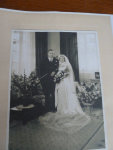
Click on image to view
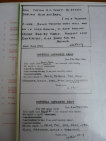
Click on image to view
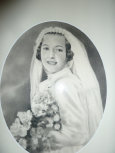
The Drawing.
Click to view
Click to view

Arthur's Apron
Click to view
Click to view
The existence of Freemasonry among prisoners of war has long been known. In fact, much has been written concerning the existence of Craft Lodges amongst the French prisoners of war captured by the English during the revolutionary War and the Peninsular Napoleonic wars. These prisoners were confined in the United Kingdom, in British Colonies or in towns temporarily occupied by the English forces.
Freemasonry within the French Army was very popular around this time and many Regiments would have had Craft Lodges attached to them. So it would be natural that when taken prisoner, to relieve the monotony of imprisonment, they would form Lodges and devote time to working Masonic ceremonies.
Many of the prisoners were initially housed in military and civil prisons, but as the numbers increased and the prisons became overcrowded, wooden hulks, anchored off shore were brought into use in Plymouth, Chatham and Portsmouth. Many artefacts such as Certificates, Aprons, Jewels, tools and contemporary Minutes still exist and can be seen in the United Grand Lodge Library and Museum at Great Queen Street.
During the period 1740 to 1815 England and France were almost continually at war. In addition, England also engaged in military and naval struggles with Holland, Denmark, Spain and the United States as a result of these countries being Allies of France Those prisoners classified as "Gentlemen" were allowed to reside on parole in certain designated towns where they received a weekly allowance to support themselves. A chance remark to a member of my Lodge resulted in him telling me that near Maidenhead, near where I live, there is a small bridge named the Parole Bridge because it was built by POWs on parole during this period.
Some of you might know that Dartmoor Prison was built by the parolees as a prison to house themselves!! In St Andrews Church in the village of Moretonhampstead near the prison, is a gravestone with an inscription to a French soldier who is shown as a "bombardier" and it has the Square and Compass engraved thereon. A local guide was recently heard explaining that as he was a bombardier, the square and compass would have been used as tools of his trade in getting the range right for the artillery!! So what further proof do we need than that Freemasonry was part of prison life?
Prisoners were exchanged on both sides, but many simply absconded. The treatment of these prisoners of war was generally fair but, as with all Prisoner of War camps there was an unruly element who fostered discontent, organised rebellion and planned escapes. POWs throughout the ages have always attempted to give their guards a hard time and to tie up as much manpower as possible.
Evidence exists of a number of Lodges being set up by these "parolees" and evidence also exists of fraternization between these French Lodges and English Lodges. Indeed a Certificate exists dated 18th April 1763, of the Launceston Parish Organist being admitted as a Joining Member in a French Lodge. It would appear that Lodge Organists were difficult to find even in those days!!
A great deal of information is published covering POWs during this period and is readily available in Masonic Libraries. This information is quite specific and gives details of Lodge names, personnel etc. Many of the French Lodges were formally approved by the Grand Lodge in France.
I would now like to bring this story more up to date by saying something about POWs during the First and Second World Wars. Up to the First World War, Freemasonry in POW camps had been accepted and encouraged as a means of keeping POWs occupied. That all changed in the First World War when meetings were conducted in secret and provided an element of risk which was vital to a prisoner's self respect. Parole became a thing of the past and prisoners were more rigidly controlled. During this period, two Lodges, No 3970 and 3976 were Founded with the assistance of the Grand Orient of the Netherlands and the Grand Lodge of England, within POW camps and both survive to this day. Brethren imprisoned in Turkey in 1918 formed a Lodge of Instruction which was structured like a formal Lodge. It should be noted here that when discussing Freemasonry in POW camps, it was this format that was employed. This Lodge of Instruction in Turkey worked degrees and discussed other Masonic matters. They must have discussed other things as well because at the close of their final meeting, they all escaped! Eight of them made it back to freedom, generally referred to as a "home run".
Turning now to the Second World War - we have all seen a number of war films depicting life in a POW camp: Colditz, the Great Escape and Bridge over the River Kwai and from these we will have built up our own idea of what life was like in these camps. But these are films and they do not reflect the endless hours of utter boredom and the feelings of frustration at being locked up and isolated from one's own friends and families. Prisoners made every attempt to learn new skills - particularly those that could be used in assisting escapes - something that was on everyone's mind. It would be natural for Freemasons to use some of this surplus time to hone their skills with the ritual. There is an excellent book called "The Barbed-wire University" by Midge Gillies which gives details of the real lives of Prisoners of War in the Second World War. There are several personal accounts which record tales of determination, courage and ingenuity in pursing their Masonic Aims. I quote from H W Wylie, a former rubber planter who asked the Commanding General for permission to hold Masonic Meetings in Changi. "The peace and tranquillity of those meetings stood out in great contrast to the turmoil and irritation of the day. Although it was very hot and most of the tie all the men were in rags, ill, hungry, tired and dirty yet it was possible during these meetings almost completely to forget the normal conditions of their lives as prisoners of war. To sit quietly among proven friends and listen to the ceremonies took one's thoughts very far from a prison camp and lifted the mind above the reach of petty annoyances, restored one's balance and demonstrated the possibility of the victory of mind over matter - a very important factor at such a time " Unquote.
We must remember that the Germans were very anti Freemasonry, but did not object to normal religious activity - hence many Masonic meetings were held under the cover of it being "a bible study group". When we think of Masonic Meetings we think of attendance at a Lodge with all that that entailed: a Temple, Officers and members in regalia, Minutes and the furniture and Tools. In the case of Meetings in a POW camp it might just be a meeting of two or three individuals in some hidden corner of a building or exercise yard. Freemasonry gave them purpose, restored their dignity, provided a pattern for living and linked past and present in a certainty of rectitude. One prisoner records that while talking to another prisoner who was making a compass for some escapees, he casually remarked that these would help anyone who felt induced to leave the East and go to the West. From this casual remark and after being proved, he discovered there were forty other known Brethren in the camp. Due to the necessary secrecy, it was not unusual to find independent groups of Brethren in the same camp and because of lack of space and the need for secrecy many meetings were held where the work was done around the table. Ritual books were a rare commodity and were usually the possession of a single Mason. These would be carefully copied and parts distributed to a number of Brethren because the discovery of such a document could often lead to severe punishment.
Japanese opposition to Masonry began after what is known as the Second China Incident in 1937 and this opposition continued to grow, particularly in Japanese occupied China, but Lodges met as normal until the outbreak of war. The attitude of the Japanese to Freemasonry in Prisoner of war camps was ambivalent and unpredictable, ranging from "turning a blind eye" to severe punishment for infraction. Thus it was that Masonic activity varied from camp to camp. Some Commanding Officers recognised the innocent nature of Freemasonry in relation to the war effort, while others saw it as a severe threat. This latter attitude, when combined with their traditional disregard for prisoners' welfare, resulted in very severe punishments. Secrecy was therefore imperative and this secrecy often led to various groups of Masons meeting in the same camp, but totally unaware of each other. We have all heard of tales of deprivation, hunger, sickness and torture, but there was also an unshakable determination to hold meetings, to rehearse ceremonies and to practise the tenets of the craft.
When Singapore fell to the Japanese in February 1942, some 50,000 disillusioned British, Australian, Dutch and Indian troops became prisoners of war of the Japanese. Originally they were held in established barracks, but by September 1943 the number was less than 25,000. Many had died from disease, malnutrition, ill treatment or execution. The remainder had been sent either to Japan to act as slave labour in the mines, to Burma or other parts of occupied Asian Countries. As the Japanese had increasing need for the barracks in Singapore for their own troops, the POWs were moved to a smaller camp and thence to Changi Jail. Changi jail was built to house six hundred prisoners but the Japanese imprisoned 22,000 POWs. Five thousand were housed in the prison and the remainder slept in crude grass huts outside the prison walls. But even under these circumstances Freemasonry flourished. Formal ritual books were like gold dust and if one was discovered with such a book, severe punishments were guaranteed and death often followed. Any Past Masters present would put together scraps of ritual and teach it by word of mouth, as it was done in the early days of Freemasonry. I wonder how we would get on, faced with the same situation today. Meetings would often be disguised as a religious meeting and, if disturbed, the WM, or some other distinguished Brother would switch to a pre-planned sermon or reading from the Bible. There are recorded incidents where the Japanese guards were utilized as Tyler, on the pretext of asking them to prevent disturbance during the "religious service". Tools, Jewels etc were made from anything they could lay their hands on: broomsticks became wands, discarded tins or a broken fan blade became the metal from which jewels were made. Gavels, square and compass were fashioned from timber taken from camp beds. Many prisoners were sent "up country" - a euphemism for being sent to work on the Burma railway. As an aside, I recently received an email from a Companion in Berkshire giving his apologies for a meeting and he told me that his father was a prisoner of war in Changi jail and he was kept alive by a fellow prisoner who later became the Deputy Provincial Grand Master of South Wales. And it was this man who was instrumental in getting my friend into Freemasonry! Escape from the Japanese was practically impossible. While British and Commonwealth forces would be able to mingle with the Northern European population that was impossible in Asia where a European face would stand out amongst the Asian population. In addition, the Japanese offered a bounty to the local population for turning in any escapees. However, despite this, there are numerous cases where prisoners exchanged anything of value like watches in exchange for food.
Freemasonry within the French Army was very popular around this time and many Regiments would have had Craft Lodges attached to them. So it would be natural that when taken prisoner, to relieve the monotony of imprisonment, they would form Lodges and devote time to working Masonic ceremonies.
Many of the prisoners were initially housed in military and civil prisons, but as the numbers increased and the prisons became overcrowded, wooden hulks, anchored off shore were brought into use in Plymouth, Chatham and Portsmouth. Many artefacts such as Certificates, Aprons, Jewels, tools and contemporary Minutes still exist and can be seen in the United Grand Lodge Library and Museum at Great Queen Street.
During the period 1740 to 1815 England and France were almost continually at war. In addition, England also engaged in military and naval struggles with Holland, Denmark, Spain and the United States as a result of these countries being Allies of France Those prisoners classified as "Gentlemen" were allowed to reside on parole in certain designated towns where they received a weekly allowance to support themselves. A chance remark to a member of my Lodge resulted in him telling me that near Maidenhead, near where I live, there is a small bridge named the Parole Bridge because it was built by POWs on parole during this period.
Some of you might know that Dartmoor Prison was built by the parolees as a prison to house themselves!! In St Andrews Church in the village of Moretonhampstead near the prison, is a gravestone with an inscription to a French soldier who is shown as a "bombardier" and it has the Square and Compass engraved thereon. A local guide was recently heard explaining that as he was a bombardier, the square and compass would have been used as tools of his trade in getting the range right for the artillery!! So what further proof do we need than that Freemasonry was part of prison life?
Prisoners were exchanged on both sides, but many simply absconded. The treatment of these prisoners of war was generally fair but, as with all Prisoner of War camps there was an unruly element who fostered discontent, organised rebellion and planned escapes. POWs throughout the ages have always attempted to give their guards a hard time and to tie up as much manpower as possible.
Evidence exists of a number of Lodges being set up by these "parolees" and evidence also exists of fraternization between these French Lodges and English Lodges. Indeed a Certificate exists dated 18th April 1763, of the Launceston Parish Organist being admitted as a Joining Member in a French Lodge. It would appear that Lodge Organists were difficult to find even in those days!!
A great deal of information is published covering POWs during this period and is readily available in Masonic Libraries. This information is quite specific and gives details of Lodge names, personnel etc. Many of the French Lodges were formally approved by the Grand Lodge in France.
I would now like to bring this story more up to date by saying something about POWs during the First and Second World Wars. Up to the First World War, Freemasonry in POW camps had been accepted and encouraged as a means of keeping POWs occupied. That all changed in the First World War when meetings were conducted in secret and provided an element of risk which was vital to a prisoner's self respect. Parole became a thing of the past and prisoners were more rigidly controlled. During this period, two Lodges, No 3970 and 3976 were Founded with the assistance of the Grand Orient of the Netherlands and the Grand Lodge of England, within POW camps and both survive to this day. Brethren imprisoned in Turkey in 1918 formed a Lodge of Instruction which was structured like a formal Lodge. It should be noted here that when discussing Freemasonry in POW camps, it was this format that was employed. This Lodge of Instruction in Turkey worked degrees and discussed other Masonic matters. They must have discussed other things as well because at the close of their final meeting, they all escaped! Eight of them made it back to freedom, generally referred to as a "home run".
Turning now to the Second World War - we have all seen a number of war films depicting life in a POW camp: Colditz, the Great Escape and Bridge over the River Kwai and from these we will have built up our own idea of what life was like in these camps. But these are films and they do not reflect the endless hours of utter boredom and the feelings of frustration at being locked up and isolated from one's own friends and families. Prisoners made every attempt to learn new skills - particularly those that could be used in assisting escapes - something that was on everyone's mind. It would be natural for Freemasons to use some of this surplus time to hone their skills with the ritual. There is an excellent book called "The Barbed-wire University" by Midge Gillies which gives details of the real lives of Prisoners of War in the Second World War. There are several personal accounts which record tales of determination, courage and ingenuity in pursing their Masonic Aims. I quote from H W Wylie, a former rubber planter who asked the Commanding General for permission to hold Masonic Meetings in Changi. "The peace and tranquillity of those meetings stood out in great contrast to the turmoil and irritation of the day. Although it was very hot and most of the tie all the men were in rags, ill, hungry, tired and dirty yet it was possible during these meetings almost completely to forget the normal conditions of their lives as prisoners of war. To sit quietly among proven friends and listen to the ceremonies took one's thoughts very far from a prison camp and lifted the mind above the reach of petty annoyances, restored one's balance and demonstrated the possibility of the victory of mind over matter - a very important factor at such a time " Unquote.
We must remember that the Germans were very anti Freemasonry, but did not object to normal religious activity - hence many Masonic meetings were held under the cover of it being "a bible study group". When we think of Masonic Meetings we think of attendance at a Lodge with all that that entailed: a Temple, Officers and members in regalia, Minutes and the furniture and Tools. In the case of Meetings in a POW camp it might just be a meeting of two or three individuals in some hidden corner of a building or exercise yard. Freemasonry gave them purpose, restored their dignity, provided a pattern for living and linked past and present in a certainty of rectitude. One prisoner records that while talking to another prisoner who was making a compass for some escapees, he casually remarked that these would help anyone who felt induced to leave the East and go to the West. From this casual remark and after being proved, he discovered there were forty other known Brethren in the camp. Due to the necessary secrecy, it was not unusual to find independent groups of Brethren in the same camp and because of lack of space and the need for secrecy many meetings were held where the work was done around the table. Ritual books were a rare commodity and were usually the possession of a single Mason. These would be carefully copied and parts distributed to a number of Brethren because the discovery of such a document could often lead to severe punishment.
Japanese opposition to Masonry began after what is known as the Second China Incident in 1937 and this opposition continued to grow, particularly in Japanese occupied China, but Lodges met as normal until the outbreak of war. The attitude of the Japanese to Freemasonry in Prisoner of war camps was ambivalent and unpredictable, ranging from "turning a blind eye" to severe punishment for infraction. Thus it was that Masonic activity varied from camp to camp. Some Commanding Officers recognised the innocent nature of Freemasonry in relation to the war effort, while others saw it as a severe threat. This latter attitude, when combined with their traditional disregard for prisoners' welfare, resulted in very severe punishments. Secrecy was therefore imperative and this secrecy often led to various groups of Masons meeting in the same camp, but totally unaware of each other. We have all heard of tales of deprivation, hunger, sickness and torture, but there was also an unshakable determination to hold meetings, to rehearse ceremonies and to practise the tenets of the craft.
When Singapore fell to the Japanese in February 1942, some 50,000 disillusioned British, Australian, Dutch and Indian troops became prisoners of war of the Japanese. Originally they were held in established barracks, but by September 1943 the number was less than 25,000. Many had died from disease, malnutrition, ill treatment or execution. The remainder had been sent either to Japan to act as slave labour in the mines, to Burma or other parts of occupied Asian Countries. As the Japanese had increasing need for the barracks in Singapore for their own troops, the POWs were moved to a smaller camp and thence to Changi Jail. Changi jail was built to house six hundred prisoners but the Japanese imprisoned 22,000 POWs. Five thousand were housed in the prison and the remainder slept in crude grass huts outside the prison walls. But even under these circumstances Freemasonry flourished. Formal ritual books were like gold dust and if one was discovered with such a book, severe punishments were guaranteed and death often followed. Any Past Masters present would put together scraps of ritual and teach it by word of mouth, as it was done in the early days of Freemasonry. I wonder how we would get on, faced with the same situation today. Meetings would often be disguised as a religious meeting and, if disturbed, the WM, or some other distinguished Brother would switch to a pre-planned sermon or reading from the Bible. There are recorded incidents where the Japanese guards were utilized as Tyler, on the pretext of asking them to prevent disturbance during the "religious service". Tools, Jewels etc were made from anything they could lay their hands on: broomsticks became wands, discarded tins or a broken fan blade became the metal from which jewels were made. Gavels, square and compass were fashioned from timber taken from camp beds. Many prisoners were sent "up country" - a euphemism for being sent to work on the Burma railway. As an aside, I recently received an email from a Companion in Berkshire giving his apologies for a meeting and he told me that his father was a prisoner of war in Changi jail and he was kept alive by a fellow prisoner who later became the Deputy Provincial Grand Master of South Wales. And it was this man who was instrumental in getting my friend into Freemasonry! Escape from the Japanese was practically impossible. While British and Commonwealth forces would be able to mingle with the Northern European population that was impossible in Asia where a European face would stand out amongst the Asian population. In addition, the Japanese offered a bounty to the local population for turning in any escapees. However, despite this, there are numerous cases where prisoners exchanged anything of value like watches in exchange for food.
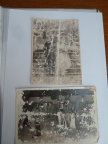
Click on image to view
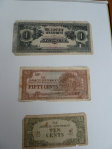
Click on image to view
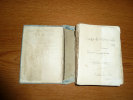
Arthur's Ritual Book
Click to view
Click to view

Freemasonry and Prisoners of War